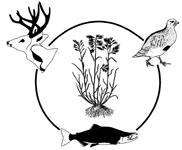Extension Wildlife & Fisheries Specialists Conferences

Triennial National Wildlife and Fisheries Extension Specialists Conference: 8th (1996)
Date of this Version
June 1996
Document Type
Article
Abstract
The purpose of a Habitat Management Plan is to use the best available science, within an adaptive framework, to provide habitat for a wide variety of native forest wildlife species while profitably managing private land for wood production. This process is currently under development by Weyerhaeuser Company in Washington State. The process starts with a Watershed Analysis conducted under the forest practices laws of the state. In this analysis, technical experts of the appropriate disciplines identify the causal mechanisms behind those processes (mass wasting, surface erosion, temperature regulation, etc.) which are related to fish habitat and water quality. With knowledge of these mechanisms, and the guidance of the technicians, foresters derive prescriptions to protect these public resources in future management activities. Habitat Management Planning itself then proceeds by setting broad resource goals appropriate to private commercial forestland. Extensive assessments of vegetative characteristics, unique habitat features, and wildlife populations are then performed to provide the initial data on which the plan will be based. A Geographic Information System is an essential tool in this process, providing a means of analyzing field data and displaying current and future habitat conditions. These data are used to evaluate and improve a series of wildlife/habitat models which are initially based primarily on relations developed from the scientific literature. This process of adaptive model improvement is fundamental to the plan. Specific management plans including harvest scheduling and silvicultural prescriptions are then derived in an integrated model which simulates forest development, identifies predicted suitable habitat, and evaluates the outcome in an economic context. Through a series of such simulations a management plan is developed which meets the broad resource goals for wildlife within acceptable economic constraints. Such a process cannot be done without a sophisticated spatial analysis which accounts for wildlife home range size, areas required for minimum viable populations, and such forest management considerations as limits on harvest area size and "green-up" rules. Monitoring of the results of plan implementation is an integral part of the adaptive process, providing a measure of plan effectiveness in meeting objectives, and guiding plan improvements over time.
This process is being developed and pilot tested on a 40,000 hectare block of commercial forestland in coastal Washington State. This presentation provides an overview of the habitat management planning process, describes the technical approaches being used to evaluate and model wildlife and habitat relationships, and displays some of the field data being collected in support of model validation.


Comments
Published in W. Daniel Edge, ed. Proceedings of the 8th National Extension Wildlife and Fisheries Specialists Workshop: Educational Challenges for the 21st Century. [1996] Corvallis, Oregon: Oregon State University, 1998.